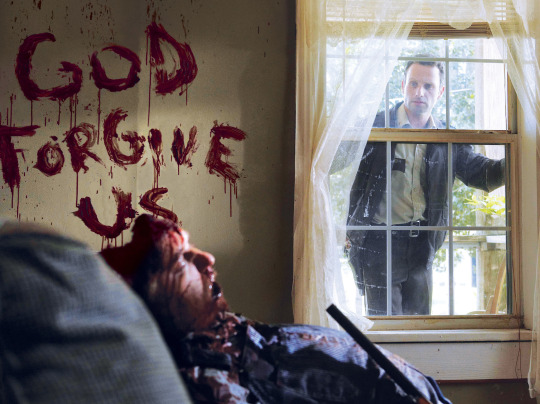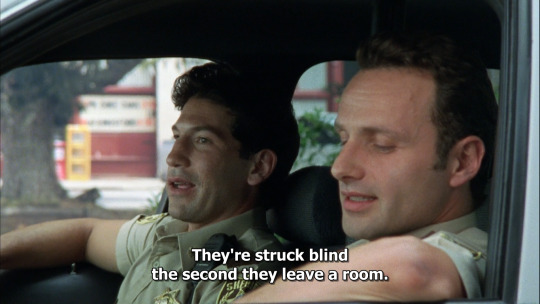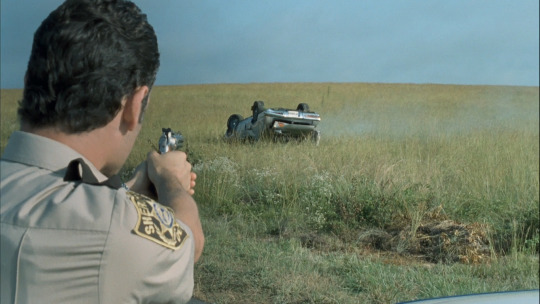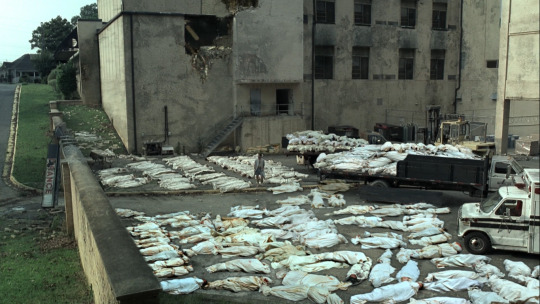Text
The Walking Dead, “Days Gone Bye” | Analysis

The final season of The Walking Dead comes in August, so I decided to rewatch the show from the beginning as the end is nigh. TWD has been a part of me since I started to watch TV series, and I’ve watched Days Gone Bye more than seven times, so this is certainly one of the pieces of audiovisual media that I’ve consumed the most. To add a new interesting layer in my rewatches, I’ve decided to see the episodes with a critical and analytical lens, seeing it more than just as a pastime, and write my thoughts here. This will be a great ride for me, and I can’t wait to see again some iconic moments from TWD throughout the seasons and write about them.
Part 1: The World Before

Before getting into the first act of the episode, let me talk about the teaser – the first five minutes of the episode – quickly. As this is our introduction to the world of TWD, Days Gone Bye couldn’t simply start with Rick and Shane having a chat. So it was necessary that the teaser served as a way to establish both the tone and setting of this story, and it certainly does. The teaser tells us that what we are watching is a gritty survival horror story that takes place in a post-apocalyptic world, and the teaser establishes this perfectly without no more than two lines of dialogue. It is established visually: Rick stops his car on a deserted road with no traces of civilization anywhere, then goes to an abandoned gas station where other cars are – and those cars have dead bodies inside. From there, we know right from the start that this isn’t the world we live in. When Rick sees the young girl that is in fact a walker, it is established that this is a world where the main threat are zombies. At least for some part, as in future episodes the series will show us something far more scarier than walking cannibal dead bodies is the real danger.
Now storytelling-wise, TWD already proved its value in the first five minutes. Frank Darabont directed the episode and wrote the script, and his work in the episode both as director and writter is fantastic and set the bar high if the series wanted to have a consistency of greatness in its episodes. After the perfect five minutes purely composed of visual storytelling, the first scene of the first act is dialogue-heavy and character-driven. One would think that it is to establish to us that Rick and Shane are friends, that Rick has a wife and son and that they are cop buddies, and one would be right, but it is also more than simply introduction and exposition, and that’s the beauty of the audiovisual medium as a whole.
Reading books about screenplay writing, I’ve come to know more about subtext and its applications in both movies and series. Despite this first scene doing great work in introducing us to the two main characters of the season – their mindset, persona and some backstory – it also adds so much worldbuilding-wise. Shane goes on his rant about women not switching off the lights in a house before leaving it, and Rick talks about a discussion he and Lori had earlier. See, the teaser showed us a decaying world with walking bodies. Now, the first minutes of act one show us a world where people worry about such trivialities: switching off the lights. In the tagline for the first volume of the comic book, it reads “The world we knew is gone. The world of commerce and frivolous necessity has been replaced by a world of survival and responsibility“. The scene I mentioned is basically the live-action adaptation of it. We see the world of commerce and frivolous necessity in this introduction so we can understand better and fear the world of survival and responsibility that will come later in the episode. TWD started geniously: it went from visually-driven to dialogue-driven, and after that to visually-driven storytelling, all without losing its verisimilitude and charm.

Now, something about the visuals I loved: the grainy aspect. Because this episode was shot on film – in fact, up until season ten all episodes were shot on film – the film grain is obviously visible. But instead of being just an aesthetic choice – shooting in film or digital – I think it’s also meant to have implications tone-wise. The comic books this series adapt is in black-and-white (something unusual in American comics), but it’s because the writer Robert Kirkman wanted the comic to feel like a classic George Romero zombie flick, and it worked completely. Commercially, a black-and-white TV series wouldn’t be much embraced by a large and mainstream public, but I think that Darabont solved that problem and succeeded in maintaining an aesthetic similar to the feel the comic book wanted to transmit. The excessive film grain – something that made me feel like watching a Panos Cosmatos’ movie but without the acid trips – works because it resembles the Romero zombie flicks in color, like Dawn of the Dead. It is a classical and archetypal zombie story – even if it subverts some conventions various times throughout the series – and the visuals tell us that.
Not only that, but the episode has many moments that resembled The Mist in some ways: the camera being close to its characters to make the story feel grounded and experienced by real people, the back shots to make the audience feel like they are following the characters in their journeys, the handhold camera moments that gives a documentary feel, adding a realistic perspective. All that grants a grounded vibe to the episode, which works because this is a story about how people react and live in a lawless world which can kill them at any possible moment without any warnings. It’s where chaos and anarchy reigns and where death always lurks. A story like that works better when it’s experienced through the eyes of the characters. It’s also best represented in the moment where Rick leaves the hospital and sees the sun for the first time. In the shot, the Sun is blinding us with its shining light, but then there’s a cut, and in the next shot we see only Rick covering his eyes while the blinding sun rays don’t make it to the camera. It’s the switch of subjective to objective perspective, as in the first we see the world with Rick eyes – it’s a man getting out of the dark for the first time in months – and in the second we see the same moment but from outside lens, and it showed us that this a day like any other where the sun doesn’t blind you. Besides, this episode has a low budget sensitivity – not meaning that the quality is subpar, but that it has an authenticity that is extremely convincing. It is that low budget quality that makes the story feel real in a certain way. That is, of course, until the tank in the middle of a city is shown, but even with the realism, it is still tangible, and the story continues to feel realistic in its depiction of a zombie apocalypse in the “real world”.
Not only that, but the episode has many moments that resembled The Mist in some ways: the camera being close to its characters to make the story feel grounded and experienced by real people, the back shots to make the audience feel like they are following the characters in their journeys, the handhold camera moments that gives a documentary feel, adding a realistic perspective. All that grants a grounded vibe to the episode, which works because this is a story about how people react and live in a lawless world which can kill them at any possible moment without any warnings. It’s where chaos and anarchy reigns and where death always lurks. A story like that works better when it’s experienced through the eyes of the characters. It’s also best represented in the moment where Rick leaves the hospital and sees the sun for the first time. In the shot, the Sun is blinding us with its shining light, but then there’s a cut, and in the next shot we see only Rick covering his eyes while the blinding sun rays don’t make it to the camera. It’s the switch of subjective to objective perspective, as in the first we see the world with Rick eyes – it’s a man getting out of the dark for the first time in months – and in the second we see the same moment but from outside lens, and it showed us that this a day like any other where the sun doesn’t blind you. Besides, this episode has a low budget sensitivity – not meaning that the quality is subpar, but that it has an authenticity that is extremely convincing. It is that low budget quality that makes the story feel real in a certain way. That is, of course, until the tank in the middle of a city is shown, but even with the realism, it is still tangible, and the story continues to feel realistic in its depiction of a zombie apocalypse in the “real world”.
The whole sequence of the car chase and the shooting between the cops and the criminals is beautifully conducted by Darabont, who knows his craft remarkably and executes it in a manner like no one else does. The memorable shots, shot by Darabont, immortalize the whole sequence and reach its climax – the gunshot Rick suffers – perfectly in a crescendo that works better here than in the comics, this being an easy task, but still, Darabont managed to do it in an impressive way, totally deserving a bravado status.
Also, something that I also appreciated, and I think it’s overlooked: when the police cruiser where Rick and Shane are passes through a road, we see a single crow eating a roadkill. What do this mean exactly? Animals can’t turn to zombies so one might think this is only a moment with no meaning behind it. But now I interprete it as a symbol. It is meant to represent that society has be decaying long before the dead came to eat the living. It remembers me the first Mad Max, where the world is not in the same level as it appears in Mad Max 2: Road Warrior – a full-on post-apocalyptic society – but it is in its final stages, leaning to barbarism and uncontrollable chaos. The producers of TWD announced an anthology spin-off series named Tales of the Walking Dead, and it certainly would be interesting to see more of the transition between our world and the post-apocalyptic zombie-ridden world, showing the process in-between of transformation and decay.
Part 2: Brave New World

The second act starts as Rick steps out of the hospital and faces the current reality of his world, and it’s an ugly one. Rick sees dead bodies everywhere and discarded military gear. Something dreadful happened when he was in a coma. The world undergone a change so great in his sleep that it’s impressive that Rick didn’t drown in total madness when he first saw what’s left of society. Most of act two is about Rick having to come to terms with his new life: one entirely ruled by survival. Now, another interesting element that is also a symbol in my interpretation: the bicycle girl. The bicycle girl (which is the zombie without its lower body) is the first walker Rick encounters. He is scared by her and runs away from her with the bicycle that was there next to him. The bicycle girl is nothing more than the remains of the past life of Rick and the world before. It is dead and alive at the same time – like the walkers – but in a pitiful state. It can’t be on its feet and is always trying to grasp and touch Rick, but, ultimately, it can’t. Rick fears it, and because of that he runs.
Most of the second act is focused on the interactions of Rick and Morgan Jones. Morgan, after encountering Rick and saving him from a nearby walker, takes him inside his house, but fearing that the gunshot wound was in fact a walker bite, Morgan rightly tied Rick to a bed and waited for him to wake up to ask some questions. Now, it’s incredible how this episode never misses a beat and is not made of only three truly great scenes, but all of the scenes are great. The whole dinamic of Morgan explaining to Rick what happened and what it takes to live in this new world felt so natural that no critic could say it was bad exposition. It was exposition done right, revealing more about Morgan’s character, showing him as a good man and a father to his son Duane. It’s easy to understand why Rick and Morgan liked each other one day after meeting for the first time. The chemistry is real, and it’s unbelievable how seasons later, when they see each other again, the chemistry is still there.
Andrew Lincoln and Lennie James are spectacular actors. Their acting in this episode is astonishingly extraordinary. I’m pissed that they didn’t won any awards for it, they certainly deserve it. Andrew’s acting was great all way through, but when he first arrives at his house and cries for Lori and Carl you could feel the man’s pain and suffering. One moment that is perfect and maybe one of the bests of all TV history is when Rick is having an existential crisis. “Is this real? Am I here?”, asks Rick while facing the ground. It’s such a powerful reaction to the absurdity he is experiencing and it feels so damn real because Andrew Lincoln can cry like a pro and give the gaze of a man that is lost. Rick is lost. And this scene can provide such a powerful punch to the audience that you can’t help but be already invested in Rick’s journey. He just wants his family, so he can put some sense in a mad world. Without them, Rick is lost.

The second act makes us empathize more with Rick and Morgan. They both have admirable goals. They just want to live and provide for their family. Their bond is developed exceptionally in their final moments together – before Rick travels to Atlanta – that you are left caring for them and wanting a reunion. The final scenes of act two were made to make you feel emotional without doubt, and I’m sure that it worked on some people and made them fall in love with the series instantly. It’s when Rick kills bicycle girl and Morgan fails to kill his dead wife, now a walker. The soundtrack by Bear McCreary is phenomenal and adds so much dramatic and emotional weight to the scenes, and it fits perfectly with the tone of pretty much the core of the series. It’s a haunting song, a sorrowful one full of melancholy, but it also has a spark of hope in it. It makes a statement: everything is sadly collapsing around us, but there’s still hope of rebuilding. The Mercy of the Living is TWD summarized in an orchestral piece, and I feel like crying every time I listen to it, just like the piece Alive Inside of Telltale’s game, that also does a masterful job in creating a sad but hopeful atmosphere in its melody. The bicycle girl – which is the past Rick and the world before – must be killed by Rick if he wants to continue his voyage, to which destination is his family. Rick is teary and heartbroken in killing bicycle girl because now he has to fully embrace a life ruled by survival. “I’m sorry this happened to you.” is Rick final message and requiem to the world and consequently to his past self – a quiet Rick that didn’t want to discuss with Lori in front of Carl –, both who had problems that they couldn’t resolve before the tragedy that hit them.
Part 3: The Beginning

The third and last act are in fact the beginning. We saw a peak of a world before the zombie apocalypse and Rick waking up in this desolated society in the first two acts, but the third one is to introduce and set up what the series is about and what will do to its end: show the characters in a battle for survival, and ultimately in a quest for the return of humanity and civilization. Both are depicted in the scenes where Rick is trying to save himself from a horde of walkers that attack him and his horse, and the other with Shane’s group listening and trying to talk in the radio with a mysterious survivor (Rick himself) who warns about his coming into the city, showing their efforts to help fellow survivors who might enter Atlanta without knowing its dangers, thus demonstrating that they are still human after all.
The episode show us a little about the relationship of Shane and Lori, as well as a glimpse to their group. It wasn’t exactly necessary, but it doesn’t hurt in any way the season’s progress and development. The third act is best represented by Rick entering Atlanta and having to escape a humongous horde of walkers. Rick manages to survive by hiding in the tank that was parked in a street. The scene also show us that zombies had some intelligence – they crawl and try to open things – and some of them look cartoonishly green or grey, instead of the realistic putrid rotting flesh look the marvelous make-up by Greg Nicotero can provide. And both of these things are common to the iconography Romero made for the zombies. It’s very clear that Darabont takes inspirations from his movies and respect their legacy by expanding it to a new range of people and an audience that is maybe not that familiar with Romero – I wasn’t when I first watched TWD and when I saw Romero’s movies I was impressed by how it influenced the series.
Days Gone Bye is a masterclass of how a pilot should be made. This quintessential pilot introduces a storyline that will be finished within the episode. while also setting up what’s coming next in the season, laying ground for all the future episodes in the best way possible. It introduces a protagonist that proves that he can sustain a show on his own – he is a caring father, loving husband, a good man and a kind of Western hero, we see him riding in his horse towards the imminent danger full of guns and determination searching only for his family. The Walking Dead may not be recognized as a TV series that revolutionized the medium, but it revolutionized its genre, and overall it is a great series that deserves recognition, and so does Days Gone Bye. It is simply the perfect pilot.
12 notes
·
View notes